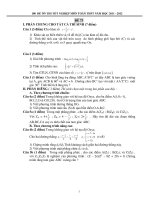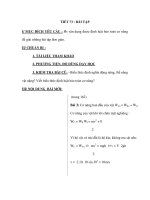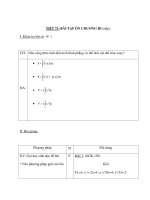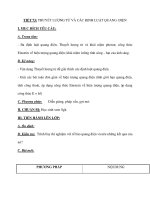73 Factoring Trinomials
Bạn đang xem bản rút gọn của tài liệu. Xem và tải ngay bản đầy đủ của tài liệu tại đây (790.23 KB, 22 trang )
Factoring Trinomials
Multiplying Binomials (FOIL)
Multiply. (x+3)(x+2)
Distribute.
x•x+x•2+3•x+3•2
F
O
I
L
= x2+ 2x + 3x + 6
= x2+ 5x + 6
Multiplying Binomials (Tiles)
Multiply. (x+3)(x+2)
Using Algebra Tiles, we have:
x +
x
x2
3
x
x
x
= x2 + 5x + 6
+
x
1
1
1
2
x
1
1
1
Factoring Trinomials (Tiles)
How can we factor trinomials such as
x2 + 7x + 12 back into binomials?
One method is to again use algebra tiles:
1) Start with x2.
x2
x
x
x
x
x
(vertical or horizontal, at
least one of each) and
x
1
1
1
1
1
twelve “1” tiles.
x
1
1
1
1
1
1
1
2) Add seven “x” tiles
Factoring Trinomials (Tiles)
How can we factor trinomials such as
x2 + 7x + 12 back into binomials?
One method is to again use algebra tiles:
1) Start with x2.
x2
x
x
x
x
x
(vertical or horizontal, at
least one of each) and
x
1
1
1
1
1
twelve “1” tiles.
x
1
1
1
1
1
1
1
2) Add seven “x” tiles
3) Rearrange the tiles
until they form a
rectangle!
We need to change the “x” tiles so
the “1” tiles will fill in a rectangle.
Factoring Trinomials (Tiles)
How can we factor trinomials such as
x2 + 7x + 12 back into binomials?
One method is to again use algebra tiles:
1) Start with x2.
2) Add seven “x” tiles
(vertical or horizontal, at
least one of each) and
twelve “1” tiles.
3) Rearrange the tiles
until they form a
rectangle!
x2
x
x
x
x
x
x
x
1
1
1
1
1
1
1
1
1
1
1
1
Still not a rectangle.
Factoring Trinomials (Tiles)
How can we factor trinomials such as
x2 + 7x + 12 back into binomials?
One method is to again use algebra tiles:
1) Start with x2.
x2
x
x
x
x
(vertical or horizontal, at
least one of each) and
x
1
1
1
1
twelve “1” tiles.
x
1
1
1
1
3) Rearrange the tiles
until they form a
rectangle!
x
1
1
1
1
2) Add seven “x” tiles
A rectangle!!!
Factoring Trinomials (Tiles)
How can we factor trinomials such as
x2 + 7x + 12 back into binomials?
One method is to again use algebra tiles:
4) Top factor:
The # of x2 tiles = x’s
The # of “x” and “1”
columns = constant.
5) Side factor:
The # of x2 tiles = x’s
The # of “x” and “1”
rows = constant.
x
+ 4
x
x2
x
x
x
x
+
x
1
1
1
1
3
x
1
1
1
1
x
1
1
1
1
x2 + 7x + 12 = ( x + 4)( x + 3)
Factoring Trinomials (Method 2)
Again, we will factor trinomials such as
x2 + 7x + 12 back into binomials.
This method does not use tiles, instead we look
for the pattern of products and sums!
If the x2 term has no coefficient (other than 1)...
x2 + 7x + 12
Step 1: List all pairs of
numbers that multiply to
equal the constant, 12.
12 = 1 • 12
=2•6
=3•4
Factoring Trinomials (Method 2)
x2 + 7x + 12
Step 2: Choose the pair that
adds up to the middle
coefficient.
12 = 1 • 12
=2•6
=3•4
Step 3: Fill those numbers
into the blanks in the
binomials:
( x + 3 )( x + 4 )
x2 + 7x + 12 = ( x + 3)( x + 4)
Factoring Trinomials (Method 2)
Factor.
x2 + 2x - 24
This time, the constant is negative!
Step 1: List all pairs of
numbers that multiply to equal
the constant, -24. (To get -24,
one number must be positive and
one negative.)
-24 = 1 • -24, -1 • 24
= 2 • -12, -2 • 12
= 3 • -8, -3 • 8
= 4 • -6, - 4 • 6
Step 2: Which pair adds up to 2?
Step 3: Write the binomial
factors.
x2 + 2x - 24 = ( x - 4)( x + 6)
Factoring Trinomials (Method 2*)
Factor. 3x2 + 14x + 8
This time, the x2 term DOES have a coefficient (other than 1)!
Step 1: Multiply 3 • 8 = 24
(the leading coefficient & constant).
24 = 1 • 24
= 2 • 12
Step 2: List all pairs of
numbers that multiply to equal
that product, 24.
Step 3: Which pair adds up to 14?
=3•8
=4•6
Factoring Trinomials (Method 2*)
Factor. 3x2 + 14x + 8
Step 4: Write temporary
factors with the two numbers.
( x + 2 )( x + 12 )
3
3
Step 5: Put the original
leading coefficient (3) under
both numbers.
( x + 2 )( x + 12 )
3
3
Step 6: Reduce the fractions, if
possible.
( x + 2 )( x + 4 )
3
Step 7: Move denominators in
front of x.
( 3x + 2 )( x + 4 )
4
Factoring Trinomials (Method 2*)
Factor. 3x2 + 14x + 8
You should always check the factors by distributing, especially
since this process has more than a couple of steps.
( 3x + 2 )( x + 4 ) = 3x • x + 3x • 4 + 2 • x + 2 • 4
= 3x2 + 14 x + 8
√
3x2 + 14x + 8 = (3x + 2)(x + 4)
Factoring Trinomials (Method 2*)
Factor 3x2 + 11x + 4
This time, the x2 term DOES have a coefficient (other than 1)!
Step 1: Multiply 3 • 4 = 12
12 = 1 • 12
(the leading coefficient & constant).
Step 2: List all pairs of
numbers that multiply to equal
that product, 12.
=2•6
=3•4
Step 3: Which pair adds up to 11?
None of the pairs add up to 11, this trinomial
can’t be factored; it is PRIME.
Factor These Trinomials!
Factor each trinomial, if possible. The first four do NOT have
leading coefficients, the last two DO have leading coefficients.
Watch out for signs!!
1) t2 – 4t – 21
2) x2 + 12x + 32
3) x2 –10x + 24
4) x2 + 3x – 18
5) 2x2 + x – 21
6) 3x2 + 11x + 10
Solution #1:
1) Factors of -21:
t2 – 4t – 21
1 • -21, -1 • 21
3 • -7, -3 • 7
2) Which pair adds to (- 4)?
3) Write the factors.
t2 – 4t – 21 = (t + 3)(t - 7)
Solution #2:
x2 + 12x + 32
1 • 32
2 • 16
4•8
1) Factors of 32:
2) Which pair adds to 12 ?
3) Write the factors.
x2 + 12x + 32 = (x + 4)(x + 8)
Solution #3:
1 • 24
2 • 12
3•8
4•6
1) Factors of 32:
2) Which pair adds to -10 ?
x2 - 10x + 24
-1 • -24
-2 • -12
-3 • -8
-4 • -6
None of them adds to (-10). For
the numbers to multiply to +24
and add to -10, they must both be
negative!
3) Write the factors.
x2 - 10x + 24 = (x - 4)(x - 6)
Solution #4:
1) Factors of -18:
x2 + 3x - 18
1 • -18, -1 • 18
2 • -9, -2 • 9
3 • -6, -3 • 6
2) Which pair adds to 3 ?
3) Write the factors.
x2 + 3x - 18 = (x - 3)(x + 18)
Solution #5:
1) Multiply 2 • (-21) = - 42;
list factors of - 42.
2) Which pair adds to 1 ?
3) Write the temporary factors.
4) Put “2” underneath.
2x2 + x - 21
1 • -42, -1 • 42
2 • -21, -2 • 21
3 • -14, -3 • 14
6 • -7, -6 • 7
( x - 6)( x + 7)
2
2
3
5) Reduce (if possible).
( x - 6)( x + 7)
2
2
6) Move denominator(s)in
front of “x”.
( x - 3)( 2x + 7)
2x2 + x - 21 = (x - 3)(2x + 7)
Solution #6:
1) Multiply 3 • 10 = 30;
list factors of 30.
2) Which pair adds to 11 ?
3) Write the temporary factors.
4) Put “3” underneath.
3x2 + 11x + 10
1 • 30
2 • 15
3 • 10
5•6
( x + 5)( x + 6)
3
3
2
5) Reduce (if possible).
( x + 5)( x + 6)
3
3
6) Move denominator(s)in
front of “x”.
( 3x + 5)( x + 2)
3x2 + 11x + 10 = (3x + 5)(x + 2)









